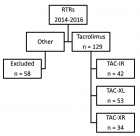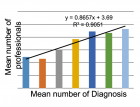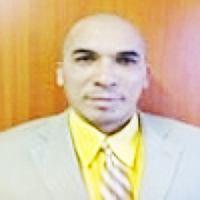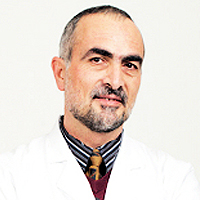Abstract
Review Article
Exploring Dermatofunctional Perspectives beyond Aesthetics: An Integrative Literature Review
Tatiane Franco, Weslley Barbosa Sales*, José Vinicius Bulhões da Silva, Djavan Gomes Leite and Giovanna Pontes Pina Vidal
Published: 21 June, 2024 | Volume 9 - Issue 2 | Pages: 027-031
Introduction: Dermatofunctional Physiotherapy is an area of physiotherapeutic specialty that aims to promote, prevent, and treat integumentary injuries. However, this field of action is usually erroneously limited to aesthetic and cosmetic procedures. However, the scope of Physical Therapy goes beyond aesthetic procedures.
Objective: To identify the scope of dermatofunctional physiotherapy beyond aesthetics.
Methodology: This is an integrative literature review with the objective of summarizing and exploring the proposed theme. For this, the PRISMA guidelines were used, as well as the PICOT strategy for a better delineation of the research question and research theme.
Results and discussions: It was observed that the role of the physiotherapist in this field is directly related to aesthetics, which is one of the most prosperous segments within the health area, due to the great demand for aesthetic procedures. Among the main resources evidenced in this study, lymphatic drainage, electrothermophototherapeutic resources, myofascial release, and manual techniques were observed.
Final considerations: The area of physical therapy is not exclusively dedicated to the aesthetic environment, it was observed that this specialty acts strongly in the promotion, and prevention of rehabilitation of patients with metabolic, integumentary, and musculoskeletal alterations, in addition to promoting and preventing diseases related to obesity, scars, geloid edema, flaccidity, and other integumentary dysfunctions.
Read Full Article HTML DOI: 10.29328/journal.jsmt.1001078 Cite this Article Read Full Article PDF
Keywords:
Physiotherapy; Aesthetics; Treatment
References
- Federal Council of Physiotherapy and Occupational Therapy. Fisioterapia.
- Fernandes MI. The role of dermatofunctional physiotherapy in the rehabilitation of burn patients: an integrative literature review. Uningá Magazine. 2019; 56(3):176-86.
- Inês Serra Pereira Caldas Melo P. Role of the Dermatofunctional Physiotherapist and its recognition by health professionals in the Lisbon region [Master's Dissertation]. Lisbon: Polytechnic Institute of Lisbon Higher School of Health Technology of Lisbon. 2014; 261.
- Mendonça AC, Azevedo KCM, Carvalho RM. Dermatofunctional Physiotherapy: scientific practice, illegal use of the category's own resources and valorization strategies. Crefito 04 - Regional Council of Physiotherapy and Occupational Therapy of the 4th region. 2011; 1(1):1-2.
- Pereira AS, Shitsuka DM, Parreira FJ, Shitsuka R. Shitsuka R. Scientific Research Methodology - Degree in Computing. [l: s.n.], 2018.
- Grambro D. Prisma System Manipulator Manual. 1. ed. Italia: PRISMA. 2005.
- Santos CMC, Pimenta CAM, Nobre MRC. The PICO Strategy for Constructing the Research Question and Searching for Evidence. Latin American Nursing Magazine. 2007; 15:3; 508-511.
- Laurence B. Content Analysis by Laurence Bardin /. 7. ed. São Paulo: Saraiva. 2011.
- Araújo CAB, Queiroz LFH, Cavalcante AS, Pontes RB. Effects of dermatofunctional physiotherapy resources on weight loss and cardiovascular risk markers in obese patients. Brazilian Journal of Exercise Physiology. 2018; 17:3; 156-64.
- Santana CML, Brito CF, Costa ACSM. Importance of physiotherapy in the rehabilitation of burn patients. Rev Bras Queimaduras.2012; 11:4; 240-245.
- Tacani PM. Decongestive physiotherapy in post-mastectomy upper limb lymphedema: retrospective study. Brazilian Journal of Health Sciences - USCS. 2014; 11:37; 17-23.
- Schuh CM. Association of high frequency, low power laser and microcurrents in the treatment of pressure injuries. Cinergis. 2017; 18:2; 99.
- Machado GC, Vieira RB, Oliveira NML, Lopes CR. Analysis of the effects of therapeutic ultrasound and electrolipophoresis on changes resulting from Geloid fibroedema. Physiotherapy in Motion.2011; 24:3; 471-479.
- Silva RMV, Martins ALMS, Maciel SCF, Resende RARC, Meyer PF. Physiotherapy protocol for the postoperative period of abdominoplasty. Ter Man. 2012; 10:49; 294-299.
- Macário FEC. Analysis of the resources used to treat sagging skin by physiotherapists in Brazil. 2014; 1-32.
- Mondo PKS, Rosas RF. Effects of galvanic current in the treatment of atrophic striae. UniSul. 2010; 1:1; 1-6.
- Diógenes GD, Andrade SRR, Cavalcante RR, Alves YM, Kuehner CP, Dermato-functional treatment for wrinkles using chemical blender and electrolifting. Fisioterapia Brasil. 2012; 13:4; 277-281.
Figures:
Similar Articles
-
Effects of a short Cardiovascular Rehabilitation program in Hypertensive subjects: A Pilot StudyJuliana Bassalobre Carvalho Borges,Débora Tazinaffo Bueno,Monique Fernandes Peres,Ana Paula Aparecida Mantuani,Andréia Maria Silva,Giovane Galdino*. Effects of a short Cardiovascular Rehabilitation program in Hypertensive subjects: A Pilot Study. . 2017 doi: 10.29328/journal.jsmt.1001008; 2: 051-056
-
The Utility of Acupuncture in Sports Medicine: A Review of the Recent LiteratureMichael Malone*. The Utility of Acupuncture in Sports Medicine: A Review of the Recent Literature. . 2017 doi: 10.29328/journal.jsmt.1001004; 2: 020-027
-
The role of UK national ligament registry as additional source of evidence for anterior cruciate ligament reconstruction: Review of the literature and future PerspectivesTarek Boutefnouchet*,Thomas Laios,Keshav Mathur. The role of UK national ligament registry as additional source of evidence for anterior cruciate ligament reconstruction: Review of the literature and future Perspectives. . 2017 doi: 10.29328/journal.jsmt.1001012; 2: 081-090
-
Seroma formation as a rare complication of lateral epicondylitis release: A case reportParth B Patel, Allison L Boden*,Bryan J Sirmon,Spero G Karas,Michael B Gottschalk. Seroma formation as a rare complication of lateral epicondylitis release: A case report. . 2017 doi: 10.29328/journal.jsmt.1001016; 2: 118-122
-
Ultrasound conjugated with Laser Therapy in treatment of osteoarthritis: A case studyAna Elisa Serafim Jorge,Michele Luise de Souza Simão,Ana Carolina Fernades,Aline Chiari,Antonio Eduardo de Aquino Junior*,Anderson Luis Zanchin,Vanderlei Salvador Bagnato. Ultrasound conjugated with Laser Therapy in treatment of osteoarthritis: A case study. . 2018 doi: 10.29328/journal.jsmt.1001023; 3: 024-027
-
A proposed Habilitation program to improve some functional parameters using Aqua-aerobic Exercises to reduce the intensity and severity of Asthma attacks among children in AlgeriaDelimi Omar,Zabchi Nor Eddine*,Mkrani Djamel. A proposed Habilitation program to improve some functional parameters using Aqua-aerobic Exercises to reduce the intensity and severity of Asthma attacks among children in Algeria. . 2019 doi: 10.29328/journal.jsmt.1001036; 4: 001-007
-
Triathlon challenge – from craggy to crazzy a different kind of pain management programMichael G Serpell*. Triathlon challenge – from craggy to crazzy a different kind of pain management program. . 2019 doi: 10.29328/journal.jsmt.1001043; 4: 050-052
-
The effects of physiotherapy and rehabilitation on Pallister-Killian Syndrome: A case reportZehra Guchan Topcu*,Selma Uzuner. The effects of physiotherapy and rehabilitation on Pallister-Killian Syndrome: A case report. . 2018 doi: 10.29328/journal.jsmt.1001035; 3: 118-123
-
Assessment of shoulder pain and somatic dysfunction in young competitive swimmers: Preventive Osteopathic Manipulative TreatmentFanny Granger,Marion Etevenard,Jean-Pascal Kily,Martin Garet*. Assessment of shoulder pain and somatic dysfunction in young competitive swimmers: Preventive Osteopathic Manipulative Treatment. . 2019 doi: 10.29328/journal.jsmt.1001045; 4: 061-066
-
The epidemiology, evaluation, and assessment of lateral ankle sprains in athletesG Javier Cavazos Jr.*,Lawrence B Harkless. The epidemiology, evaluation, and assessment of lateral ankle sprains in athletes. . 2021 doi: 10.29328/journal.jsmt.1001052; 6: 008-017
Recently Viewed
-
Trends in TeledentistryRudrakshi C*. Trends in Teledentistry. J Clin Adv Dent. 2020: doi: 10.29328/journal.jcad.1001014; 4: 004-005
-
Au26-35: A Special Geometrical Structure of Au33 (D2) Cluster with Highly Occupied - 14 Pairs of Double-State DegeneracyK Vishwanathan*. Au26-35: A Special Geometrical Structure of Au33 (D2) Cluster with Highly Occupied - 14 Pairs of Double-State Degeneracy. Ann Adv Chem. 2022: doi: 10.29328/journal.aac.1001035; 6: 063-080
-
Texture of Thin Films of Aluminum Nitride Produced by Magnetron SputteringStrunin Vladimir Ivanovich,Baranova Larisa Vasilievna*,Baisova Bibigul Tulegenovna. Texture of Thin Films of Aluminum Nitride Produced by Magnetron Sputtering. Int J Phys Res Appl. 2025: doi: 10.29328/journal.ijpra.1001106; 8: 013-016
-
Minimising Carbon Footprint in Anaesthesia PracticeNisha Gandhi and Abinav Sarvesh SPS*. Minimising Carbon Footprint in Anaesthesia Practice. Int J Clin Anesth Res. 2024: doi: 10.29328/journal.ijcar.1001025; 8: 005-007
-
On Friedman equation, quadratic laws and the geometry of our universeS Kalimuthu*. On Friedman equation, quadratic laws and the geometry of our universe. Int J Phys Res Appl. 2021: doi: 10.29328/journal.ijpra.1001041; 4: 048-050
Most Viewed
-
Evaluation of Biostimulants Based on Recovered Protein Hydrolysates from Animal By-products as Plant Growth EnhancersH Pérez-Aguilar*, M Lacruz-Asaro, F Arán-Ais. Evaluation of Biostimulants Based on Recovered Protein Hydrolysates from Animal By-products as Plant Growth Enhancers. J Plant Sci Phytopathol. 2023 doi: 10.29328/journal.jpsp.1001104; 7: 042-047
-
Sinonasal Myxoma Extending into the Orbit in a 4-Year Old: A Case PresentationJulian A Purrinos*, Ramzi Younis. Sinonasal Myxoma Extending into the Orbit in a 4-Year Old: A Case Presentation. Arch Case Rep. 2024 doi: 10.29328/journal.acr.1001099; 8: 075-077
-
Feasibility study of magnetic sensing for detecting single-neuron action potentialsDenis Tonini,Kai Wu,Renata Saha,Jian-Ping Wang*. Feasibility study of magnetic sensing for detecting single-neuron action potentials. Ann Biomed Sci Eng. 2022 doi: 10.29328/journal.abse.1001018; 6: 019-029
-
Pediatric Dysgerminoma: Unveiling a Rare Ovarian TumorFaten Limaiem*, Khalil Saffar, Ahmed Halouani. Pediatric Dysgerminoma: Unveiling a Rare Ovarian Tumor. Arch Case Rep. 2024 doi: 10.29328/journal.acr.1001087; 8: 010-013
-
Physical activity can change the physiological and psychological circumstances during COVID-19 pandemic: A narrative reviewKhashayar Maroufi*. Physical activity can change the physiological and psychological circumstances during COVID-19 pandemic: A narrative review. J Sports Med Ther. 2021 doi: 10.29328/journal.jsmt.1001051; 6: 001-007

HSPI: We're glad you're here. Please click "create a new Query" if you are a new visitor to our website and need further information from us.
If you are already a member of our network and need to keep track of any developments regarding a question you have already submitted, click "take me to my Query."


















































































































































